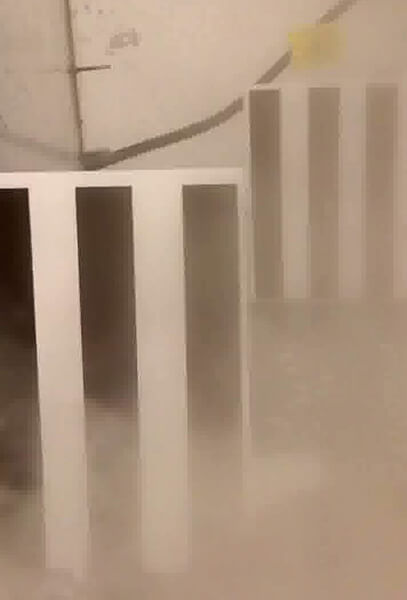August 5, 2020
Real-time imaging can help prevent deadly dust explosions
 Purdue innovators have created technology to help prevent dust explosions. (Image provided)
Purdue innovators have created technology to help prevent dust explosions. (Image provided)
WEST LAFAYETTE, Ind. – Dust explosions can be among the most dangerous and costly workplace incidents. Dust builds up in agricultural, powder-handling or manufacturing settings, causing hazards to employees and posing the risk of exploding.
Researchers at Purdue University have developed an image- and video-based application using OpenCV algorithms that detect explosible suspended dust concentration. The app uses a camera or a video recording device to image and determine suspended dust and to accurately distinguish it from normal background noise.
The Purdue team’s work is published in the Journal of Loss Prevention in the Process Industries.
“Determining suspended dust concentration allows employers to take appropriate safety measures before any location within the industry forms into an explosive atmosphere,” said Kingsly Ambrose, an associate professor of agricultural and biological engineering who leads the research team. “I believe this technology could help prevent dust explosions and will be of great benefit to the industry.”
Ambrose said current technology for detecting dust levels is inconvenient because it is expensive, difficult to install in a workspace and separates dust matter into multiple filters that must be weighed and further manipulated for analysis.
Ambrose said that in testing, the algorithm successfully recognized 95% of saw dust and 93% of cornstarch particulates in the air.
“This technology is unique because it is easy to use without extended training, location independent and does not require permanent installations,” Ambrose said.
Ambrose and the team have worked with the Purdue Research Foundation Office of Technology Commercialization to patent the technology. They are looking to license it and are seeking collaborators for further development. For more information, contact Abhijit Karve of OTC at aakarve@prf.org and reference track codes 2020-AMBR-68881 and 68902.
About Purdue Research Foundation Office of Technology Commercialization
The Purdue Research Foundation Office of Technology Commercialization operates one of the most comprehensive technology transfer programs among leading research universities in the U.S. Services provided by this office support the economic development initiatives of Purdue University and benefit the university's academic activities through commercializing, licensing and protecting Purdue intellectual property. The office recently moved into the Convergence Center for Innovation and Collaboration in Discovery Park District, adjacent to the Purdue campus. In fiscal year 2020, the office reported 148 deals finalized with 225 technologies signed, 408 disclosures received and 180 issued U.S. patents. The office is managed by the Purdue Research Foundation, which received the 2019 Innovation and Economic Prosperity Universities Award for Place from the Association of Public and Land-grant Universities. In 2020, IPWatchdog Institute ranked Purdue third nationally in startup creation and in the top 20 for patents. The Purdue Research Foundation is a private, nonprofit foundation created to advance the mission of Purdue University. Contact otcip@prf.org for more information.
About Purdue University
Purdue University is a top public research institution developing practical solutions to today’s toughest challenges. Ranked the No. 6 Most Innovative University in the United States by U.S. News & World Report, Purdue delivers world-changing research and out-of-this-world discovery. Committed to hands-on and online, real-world learning, Purdue offers a transformative education to all. Committed to affordability and accessibility, Purdue has frozen tuition and most fees at 2012-13 levels, enabling more students than ever to graduate debt-free. See how Purdue never stops in the persistent pursuit of the next giant leap at purdue.edu.
Writer: Chris Adam, cladam@prf.org
Source: Kingsly Ambrose, rambrose@purdue.edu
Photo Caption: Purdue innovators have created technology to help prevent dust explosions. (Image provided) https://www.purdue.edu/uns/images/2020/ambrose-sensorLO.jpg
Journalists visiting campus: Journalists should follow Protect Purdue protocols and the following guidelines:
- Campus is open, but the number of people in spaces may be limited. We will be as accommodating as possible, but you may be asked to step out or report from another location.
- To enable access, particularly to campus buildings, we recommend you contact the Purdue News Service media contact listed on the release to let them know the nature of the visit and where you will be visiting. A News Service representative can facilitate safe access and may escort you on campus.
- Wear face masks inside any campus building. Wear face masks outdoors when social distancing of at least six feet is not possible.
ABSTRACT
A real-time method for sensing suspended dust concentration from the light extinction coefficient
Yumeng Zhao and Kingsly Ambrose
In powder handling and processing industry, location of dust emission can vary, with the suspended dust concentration assessment requiring installation of an immovable or wired equipment. For increased dust sensing, not limited by location within the facility, a portable suspended dust concentration measuring system is needed. In this study, a new method of sensing suspended dust concentration under daylight environment using the change in light extinction coefficient was developed. The method involves capturing images of the suspended dust cloud and then analyzing the light extinction coefficient. This method mitigated the environmental light scattering and absorption and eliminated the noise from the images obtained through a camera by calibration between two targets. Cornstarch, corn dust, and sawdust were used as test materials in this study. The light extinction coefficient (ε) was found to correlate with the suspended dust concentration, and the ε values depended on the dust properties. Mass extinction coefficient (K) was obtained for cornstarch, saw dust and corn dust, from known suspended dust concentrations using image analysis. The mass extinction coefficient of the three sample materials tested in this study were in the range of 0.03–0.04. This method of using light extinction coefficient can be used for real-time sensing of suspended dust concentration in both open and confined spaces.
Note to journalists: Journalists visiting campus should follow visitor health guidelines

